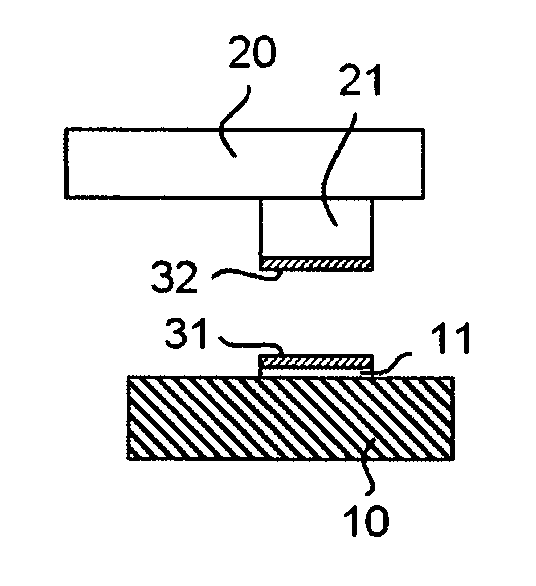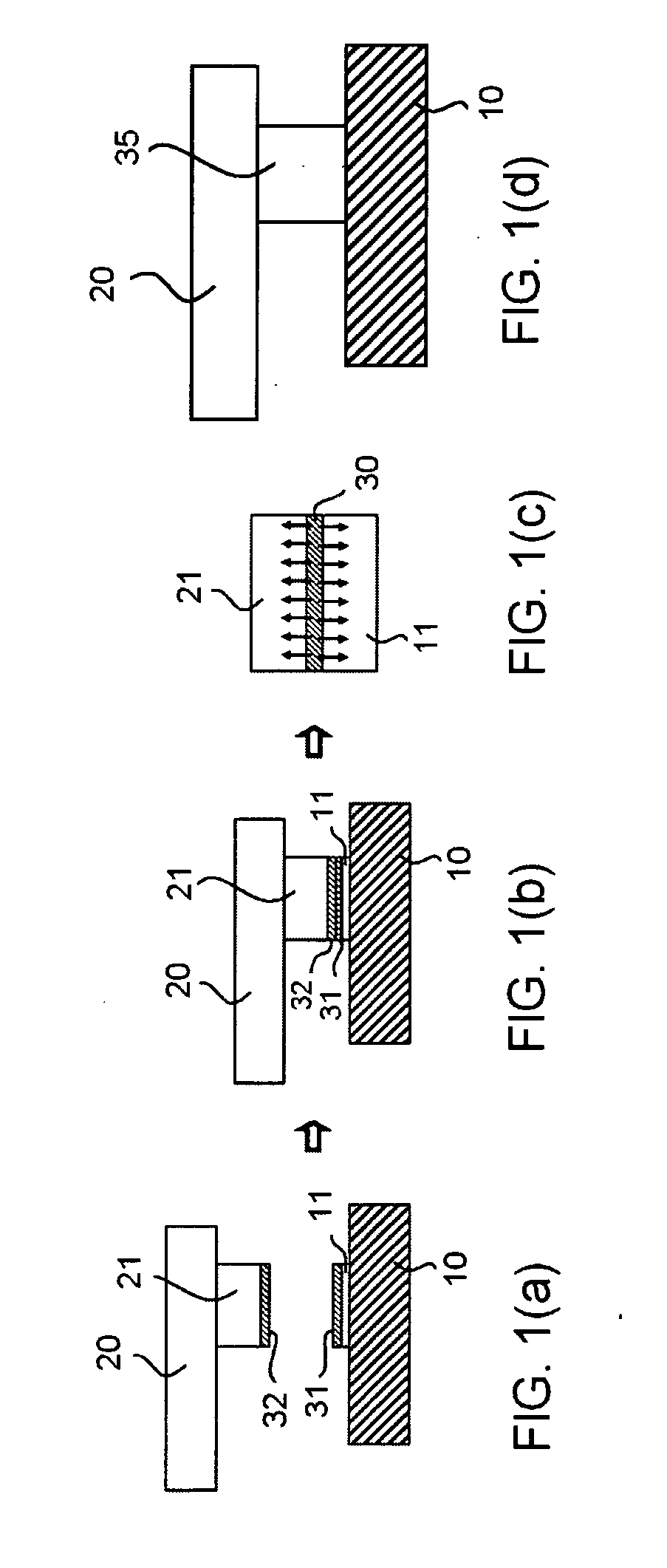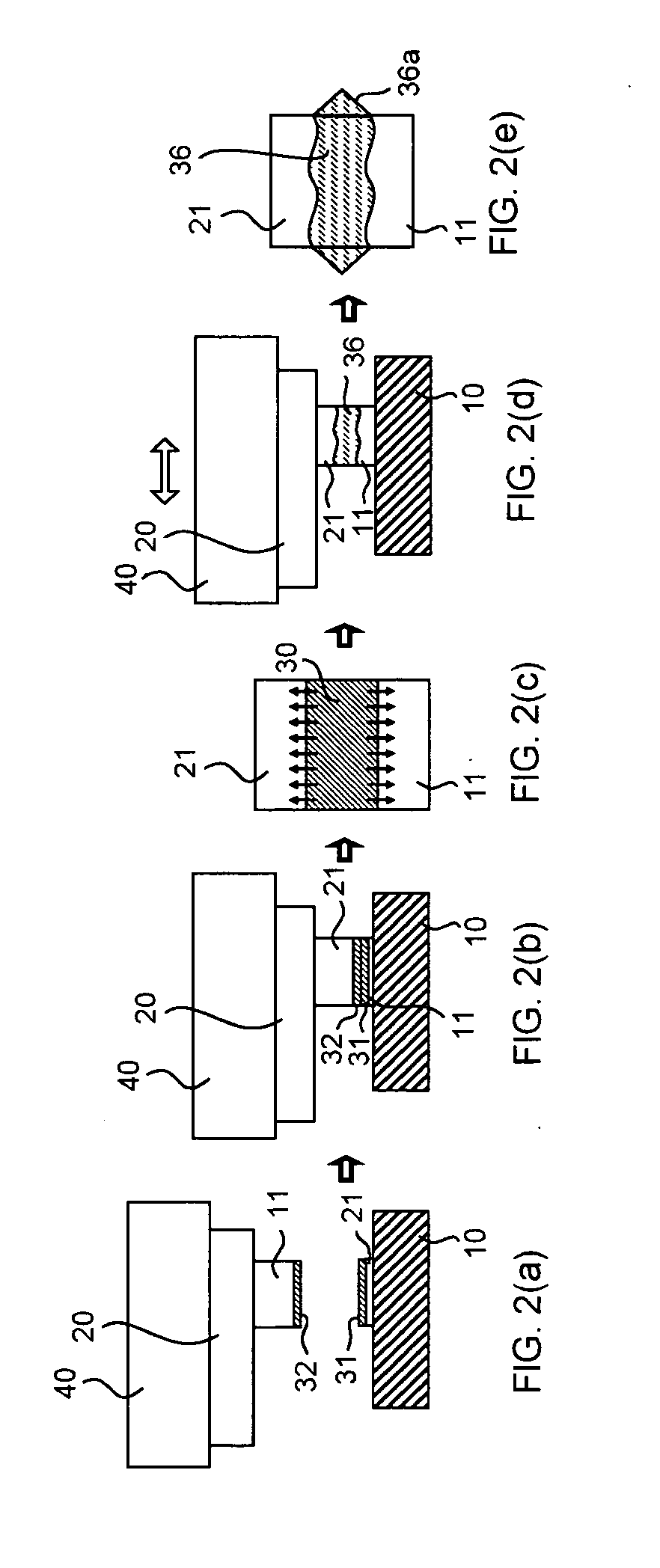Electronic part mounting method
a technology for mounting methods and electronic parts, applied in the field of electronic part mounting methods, can solve the problems of insufficient long curing time of resin, and thermal damage of the electronic part, and achieve the effect of shortening the time necessary for joining, enhancing the reliability of the joining portion, and avoiding thermal damag
- Summary
- Abstract
- Description
- Claims
- Application Information
AI Technical Summary
Benefits of technology
Problems solved by technology
Method used
Image
Examples
example 1
[0116] An electronic part is mounted on a circuit board using the method shown in FIG. 1.
[0117] First of all, a semiconductor chip is used as the electronic part, and bumps made of Cu are formed over the semiconductor chip as electrodes. On the other hand, Cu electrodes are formed over the circuit board.
[0118] Next, as a low-melting-point metal layer, over the Cu bump of the semiconductor chip and over the Cu electrode of the circuit board, an SnIn layer (melting point: 117° C.) having a total thickness of 4 μm, wherein an Sn layer has a thickness of 2 μm and In layer having a thickness of 2 μm is formed by vapor deposition.
[0119] Here, in a vapor deposition method, mother alloy made of SnIn (In:Sn=52:48) is used as an evaporation source, and a film is formed by controlling a vapor deposition condition such that the vapor pressure ratio (PA / PB)=0.81 in the above-mentioned formula (12) becomes (PA / PB)=0.81. Here, an electron beam vapor deposition apparatus is used as a vapor depos...
embodiment 2
[0123] The joining of a semiconductor chip and a circuit board is performed under the same condition as the embodiment 1 except for that, in the formation of a low-melting-point metal layer vapor deposition, a film is formed by controlling a product of a vapor pressure ratio and an activity constant ratio (γAPA / γBPB)=0.98 in the above-mentioned formula (16) becomes (γAPA / γBPB)=0.98.
[0124] As a result, the composition of the formed SnIn thin film is set to In:Sn=52:48 and hence, the low-melting-point metal layer having the target alloy composition is obtained. Further, after joining, as shown in FIG. 1(d), it is confirmed by a cross-section observation using a high vacuum scanning electron microscope and an element analysis of a joining interface by an X-ray micro analyzer (EPMA) that SnIn is completely diffused in the Cu electrode and the joining portion which constitutes one alloy layer as a whole in which an intermediate alloy layer is not present is obtained.
example 3
[0125] An electronic part is mounted on a circuit board using the method shown in FIG. 1.
[0126] First of all, a semiconductor chip is used as the electronic part, and bumps made of Cu are formed over the semiconductor chip as electrodes. On the other hand, Cu electrodes are formed over the circuit board.
[0127] Next, as a low-melting-point metal layer, over the Cu bump of the semiconductor chip and over the Cu electrode of the circuit board, an Sn layer having a thickness of 0.48 μm and an In layer having a thickness of 0.52 μm are sequentially formed as a single metal layer by vapor deposition such that a total thickness becomes 1 μm.
[0128] Then, as shown in FIG. 1(a), the Cu bump of the semiconductor chip and the Cu electrode of the circuit board are aligned with each other and, thereafter, as shown in FIG. 1(b), the electrodes are brought into contact with each other. Then, preheating is performed at a temperature of 120° C. for 10 seconds so as to form the Sn layer and the In ...
PUM
| Property | Measurement | Unit |
|---|---|---|
| temperature | aaaaa | aaaaa |
| surface roughness Ra | aaaaa | aaaaa |
| temperature | aaaaa | aaaaa |
Abstract
Description
Claims
Application Information
 Login to View More
Login to View More - R&D
- Intellectual Property
- Life Sciences
- Materials
- Tech Scout
- Unparalleled Data Quality
- Higher Quality Content
- 60% Fewer Hallucinations
Browse by: Latest US Patents, China's latest patents, Technical Efficacy Thesaurus, Application Domain, Technology Topic, Popular Technical Reports.
© 2025 PatSnap. All rights reserved.Legal|Privacy policy|Modern Slavery Act Transparency Statement|Sitemap|About US| Contact US: help@patsnap.com



